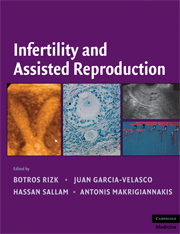Book contents
- Frontmatter
- Contents
- Contributors
- Foreword
- Preface
- Introduction
- PART I PHYSIOLOGY OF REPRODUCTION
- 1 Folliculogenesis: From Preantral Follicles to Corpus Luteum Regression
- 2 Mechanisms of Follicular Development: The Role of Gonadotrophins
- 3 Human Follicle Culture In Vitro
- 4 Endometrial Receptivity
- 5 Molecular Mechanisms of Implantation
- PART II INFERTILITY EVALUATION AND TREATMENT
- PART III ASSISTED REPRODUCTION
- PART IV ETHICAL DILEMMAS IN FERTILITY AND ASSISTED REPRODUCTION
- Index
- Plate section
- References
1 - Folliculogenesis: From Preantral Follicles to Corpus Luteum Regression
from PART I - PHYSIOLOGY OF REPRODUCTION
Published online by Cambridge University Press: 04 August 2010
- Frontmatter
- Contents
- Contributors
- Foreword
- Preface
- Introduction
- PART I PHYSIOLOGY OF REPRODUCTION
- 1 Folliculogenesis: From Preantral Follicles to Corpus Luteum Regression
- 2 Mechanisms of Follicular Development: The Role of Gonadotrophins
- 3 Human Follicle Culture In Vitro
- 4 Endometrial Receptivity
- 5 Molecular Mechanisms of Implantation
- PART II INFERTILITY EVALUATION AND TREATMENT
- PART III ASSISTED REPRODUCTION
- PART IV ETHICAL DILEMMAS IN FERTILITY AND ASSISTED REPRODUCTION
- Index
- Plate section
- References
Summary
INTRODUCTION
The most common function of the female gonad is to produce gametes, the oocytes, and sex hormones, such as estrogens and progesterone, which control the development of the female secondary sexual characteristics and support pregnancy. These two functions are exerted cyclically between puberty and the menopause, and they are regulated by diverse endocrine and paracrine factors acting on many cell types situated in the ovary. Ovarian functions result from the evolution of a morphological unit, the ovarian follicle, which consists of a central oocyte surrounded by granulosa cells and other layers of somatic theca cells (1). The maturation of the follicle proceeds through primordial, primary, and secondary stages of development and is controlled by various factors produced in the ovary. The main physiological stimulants for differentiation and luteinization of granulosa cells, which are a main cellular component of the follicle, are the gonadotropin hormones, follicle-stimulating hormone (FSH), and luteinizing hormone (LH). Throughout the reproductive life span of the female, only limited number of follicles will reach the stage of Graafian follicle and will ovulate, whereas the vast majority is gradually eliminated through a process called atresia. In every menstrual cycle, only one follicle, named the dominant follicle, is destined to complete maturation and ovulate, and thus, the formation of the multiple embryos during pregnancy is prevented.
Keywords
- Type
- Chapter
- Information
- Infertility and Assisted Reproduction , pp. 3 - 9Publisher: Cambridge University PressPrint publication year: 2008



